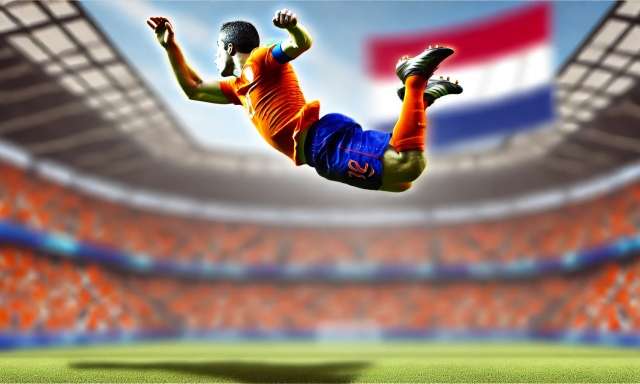Robin van Persie: The Flying Dutchman – Aerial Precision in Football
Robin van Persie, the Dutch football legend, earned his nickname “The Flying Dutchman” for a reason that goes beyond football. During the 2014 FIFA World Cup, he delivered one of the most iconic aerial goals in the sport’s history. The moment he took flight to head the ball over Spain’s goalkeeper was akin to a perfectly executed aerial maneuver. Van Persie’s precision, timing, and control in the air drew parallels to the world of aviation, where the smallest details can make or break a flight.
The Aerial Maneuver: Robin Van Persie Takes Flight
On June 13, 2014, the Netherlands took on Spain in a high-stakes World Cup match. With Spain being the reigning world champions, the pressure was intense, much like a pilot navigating through stormy skies. Van Persie, however, rose to the occasion—literally.
In the 44th minute, Dutch defender Daley Blind sent a long ball from midfield, setting the stage for Van Persie’s “takeoff.” Sprinting towards the penalty box, Van Persie read the trajectory of the ball like a seasoned pilot scanning his flight path. With no hesitation, he launched himself into the air, stretching his body like a jet fighter lifting off the runway.
Rather than opting for a conventional play, Van Persie executed a mid-air header that resembled an aerial acrobat’s daring move. His flight path was deliberate and controlled, arching perfectly to guide the ball over Spanish goalkeeper Iker Casillas. The ball’s trajectory was akin to a smooth descent from cruising altitude, gracefully finding its target in the net. It was an aerial masterpiece, a move that left spectators and analysts stunned, much like watching an aircraft defy gravity with a flawless stunt.

Why Robin Van Persie’s Goal Mirrors an Aerial Masterpiece
Just like a pilot executing a complex maneuver, Van Persie’s goal relied on precision, timing, and situational awareness. Here’s why the football world still sees this goal as a moment of aerial brilliance:
- Altitude control: Much like an aircraft hitting its perfect cruising altitude, Van Persie judged his jump with pinpoint accuracy, allowing him to meet the ball at the optimal height for impact.
- Trajectory management: His body’s flight path was smooth, arcing in a way that controlled the ball’s direction, ensuring it would clear the goalkeeper. It was like a glider making a controlled descent, with the ball following a calculated trajectory.
- Split-second decision-making: In aviation, pilots must make rapid decisions under pressure. Van Persie’s choice to take flight, rather than attempt a ground play, mirrors a pilot’s ability to think quickly and react in real time.
The Origins of “The Flying Dutchman” Nickname
The moniker “The Flying Dutchman” is rich with both football and aviation metaphors. Historically, it references a ghost ship from Dutch folklore doomed to sail the seas eternally. However, in the context of Van Persie’s goal, it symbolized his ability to take flight when it mattered most, navigating the pitch with the same confidence as a pilot navigating the skies.
In aviation terms, Van Persie’s ability to control his body mid-air mirrored a pilot’s skill in adjusting an aircraft’s altitude, trajectory, and balance. The term “The Flying Dutchman” became synonymous with his remarkable aerial ability. Like a skilled aviator, Van Persie made the skies of the football pitch his domain.

image source: link
The Aerial Impact: Changing the Course of the Match
Van Persie’s flight didn’t just result in an iconic goal—it altered the course of the entire match. Much like a tactical airstrike that shifts the momentum of a battle, his flying header set the stage for the Netherlands to dominate the game, ultimately defeating Spain 5-1.
In aviation, the timing and precision of an operation can determine its success. In this regards, Van Persie’s perfectly timed header was a prime example. His goal struck at the right moment, breaking through Spain’s defense like a carefully planned air raid. From that moment on, Spain’s defense collapsed, and the Netherlands soared to victory.
A Footballer Who Mastered the Skies
Robin van Persie enjoyed an illustrious football career, playing for top clubs such as Arsenal, Manchester United, and Fenerbahçe, scoring over 200 goals at the club level. However, it was his flying header during the 2014 World Cup that became his defining moment. It was a moment that demonstrated his mastery of aerial play, much like a pilot mastering complex flight maneuvers.
Throughout his career, Van Persie was known for his athleticism, technical ability, and lethal finishing. But this goal was different. It wasn’t just a show of strength; it was a testament to his understanding of timing and spatial awareness, much like an aviator calculating every move before takeoff.
Why Robin Van Persie’s Header Was a Tactical “Airstrike”
Van Persie’s flying header could be compared to a well-executed aerial operation in the world of aviation warfare. In military terms, precision airstrikes require careful planning, a clear target, and perfect execution. Van Persie’s goal hit all those marks:
- Target locked: Van Persie saw the opportunity and seized it, much like a fighter pilot identifying and locking onto a target.
- Steady approach: His leap into the air was calculated and precise, just like the ascent of an aircraft. The controlled flight path ensured that he would meet the ball at the right point for maximum impact.
- Perfect execution: His aerial maneuver was flawless. Van Persie’s “strike” left Spain’s defense in disarray, and the Dutch team capitalized on the confusion to dominate the rest of the match.
Conclusion
Robin van Persie’s legendary flying header at the 2014 World Cup wasn’t just a moment of football brilliance—it was an aerial masterclass. Like a seasoned aviator, Van Persie controlled every aspect of his flight: the takeoff, the trajectory, and the perfect landing in the back of the net. His goal, which remains one of the greatest headers in World Cup history, will forever be remembered as a high-flying maneuver that redefined the art of aerial play in football.
In aviation, the most daring and successful pilots are those who can make split-second decisions while maintaining precision and control. In football, Van Persie was no different. His flying header was a moment of pure skill, athleticism, and tactical brilliance—a footballer who truly mastered the skies.


